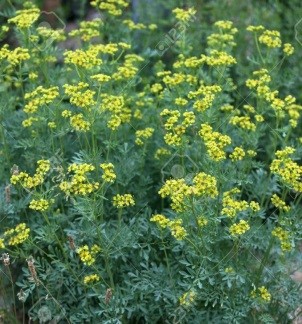Area
Grows on dry rocky and gravelly slopes in southern Crimea.
Botanical description of the plant
Fragrant ruta-Ruta graveolens L., rutados - belongs to the family Rutaceae. Height 70cm. The smell of up to a pleasant half-bush. The stem is woody, the underside is branched, forming many annual branches each year. The leaves are simple, the general appearance is triangular-shaped, separated by two or three petals, gray-green, arranged in a row with a long stalk at the base. The leaf blades are elongated inverted ovoid, with a blunt tip, with many spots (areas where the essential oil is stored). The flowers are greenish-yellow, clustered in a thyroid inflorescence. In the upper flowers there are 5 flower cups and petals, the rest are 4, the paternal 8-10, the maternal node 4-5, above. The fruit is a 4-5-chambered, spherical cup. It blooms in June-July.

Medicinal properties
In medicine, preparations of the above-ground part of the fragrant rhubarb plant are used in the treatment of headaches, pneumonia, rheumatism, diseases caused by fatigue in children, caused by vascular spasm. It is also used in the treatment of scabies and other skin diseases.
Growing technology
Ruta grows naturally in the Mediterranean, Southern Europe, Asia, including Uzbekistan. It is grown in large areas in Russia, Ukraine and Belarus. Currently, it is grown on small areas of some irrigated lands of the Republic of Uzbekistan. Medicinal ruta plant grows well if it is planted in fertile, mechanically moderate and structured soils or if the land is separated from legumes, and more raw materials can be harvested. Before preparing the lands for cultivation of medicinal ruta plant in the fall, it is plowed to a depth of 25-28 cm, giving 20-30 tons of manure and 40-50 kg of phosphorus fertilizer per hectare. In early spring, ie in early March, when the soil temperature (in a layer of 10-15 cm) is 15-20 ° C, ruta seeds are sown at a depth of 1-1.5 cm, row spacing is 15 cm, row spacing is 70 cm. so vegetables are grown in planting equipment. Ruta is propagated by seeds. Because the seed of the plant is so small, it grows slowly. If the soil is moist enough, the seeds will germinate after 6-8 days. In areas with insufficient moisture, plots are taken for irrigation at the same time as planting. Once the plant has sprouted from the ground, cultivation begins. In order to ensure good development of the ruta, to grow a quality and abundant crop from it, the row spacing is softened by cultivation and weeded. Because weeds and insects can do more damage. When the plant produces 2-3 true leaves, the rows are cleared of weeds and 2-3 plants are left in each bush. If the seeds are not fully germinated, it is advisable to use vigorous plants that have grown as a result of weeding (remong) to fill those areas. The ruta plant is fed with pure nitrogen at the rate of 40 kg per hectare and 20 kg of potassium fertilizer for good growth and development during the growing season. The second feeding ruta plant is fed with 30 kg of nitrogen per hectare and 20 kg of phosphorus fertilizer per hectare during the period of entering the hive. Feeding should be done before each watering. After watering, the intervals of the ruta plant are loosened and cleared of weeds.The ruta plant is finished by giving 30 kg of nitrogen and potassium fertilizer before flowering until the last feeding as it is demanding on nutrients. During the growing season, the ruthenium is watered 7-8 times in the first year, taking into account air temperature and soil moisture. The ruta plant bears fruit in the second year. In the second and subsequent years, the number of irrigations and intercropping is significantly reduced, and its feeding is carried out after the harvest of raw materials. Its raw material is harvested twice during the growing season until the flowering phase. The product of the ruta is harvested with a hay or silage harvester, leaving 5 cm above the ground. If the rhubarb plant is well cared for during the growing season (fertilization, irrigation, intercropping, against pests and diseases), 4-5 tons of green mass per hectare, 600-700 kg of dry product (leaves, flowers) and 80-90 kg of seeds can be harvested. . Like all cultivated plants, spider mites, insect larvae, leaf sap cause more damage to the ruta plant during the growing season. To prevent the disease is treated with 10% sulfur calloid suspension and deciduous solution.





